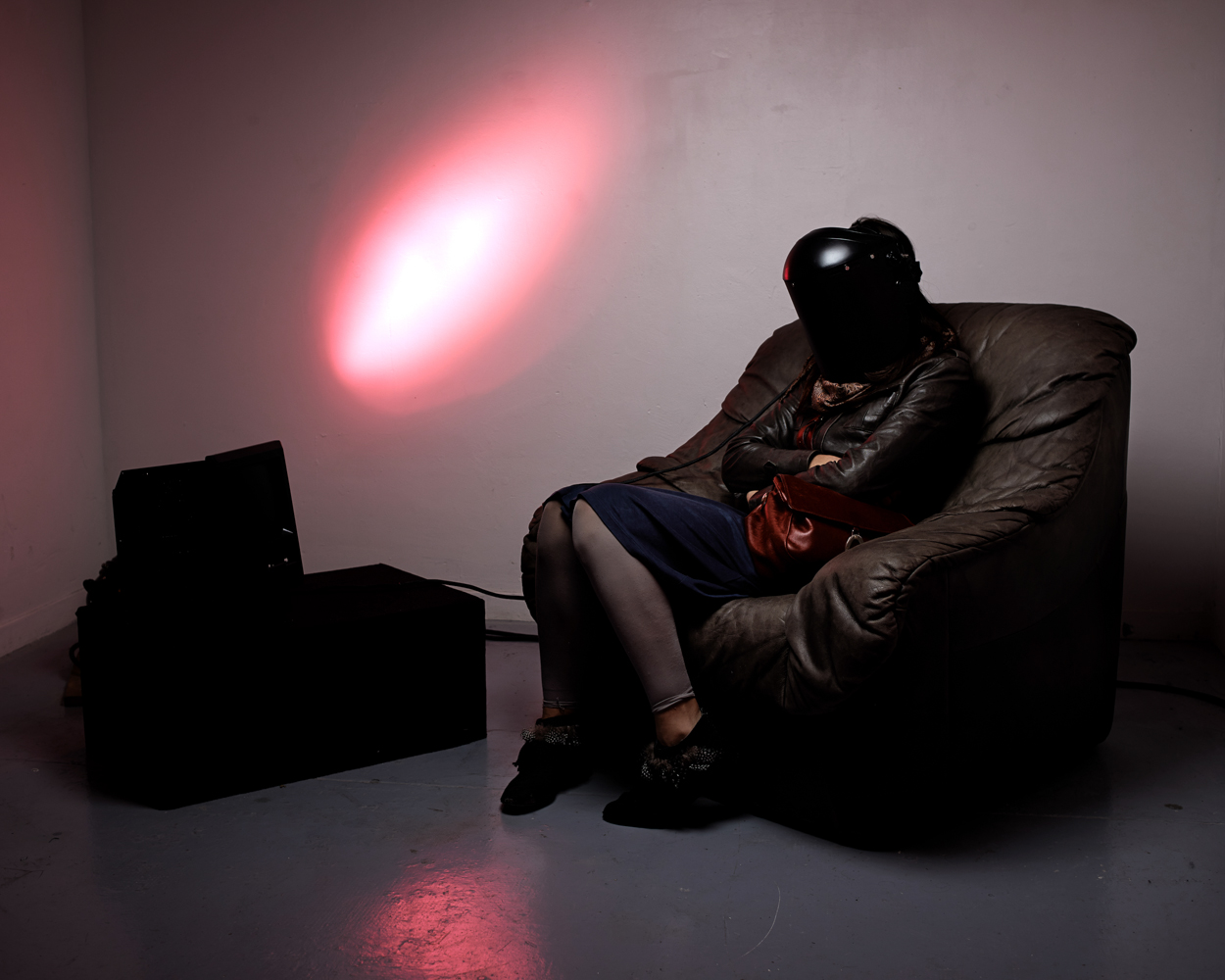Helmetron invites the spectator to sit, relax, put on a light and sound helmet, and enjoy an immersive sensory journey into digital pictures. Not into the pictures’ graphics but into their raw data. From the first to the last byte, binary files are transformed into light and sound stimuli which generate images and sensations proper to each spectator sensorium.
Helmetron is made of a LED visor and headphones. A microcomputer runs a program that translates raw data into light and sound. As a result, this helmet produces an experience one might think of as a glitchy version of Brion Gysin’s Dream Machine. By diving into the heart of the machine we feel its own data flow and experience visual illusions induced by the files turned into sensory stimuli. Thought as a light and sound instrument for computers, Helmetron breaks through the barrier of conventional virtual reality interfaces and allows for an organic link between the participant and the computer’s digital processes.
Helmetron is an immersive one-person artwork consisting of a security visor and helmet customized with LEDs, headphones, and a microcomputer. The helmet is painted in mat black and accompanied by the carcass of an old computer that hides the actual microcomputer and enhances the critical technological aesthetic of the work. Finally, a large and comfortable armchair completes the set up. When entering the room, the spectator is invited to sit in the armchair, relax, adjust the helmet, and enjoy the experience. The experience can last as long as the participants desire and other spectators are preventing from entering in contact with them.
Helmetron produces a stream of synchronous light and sound generated by the raw data stored on a microcomputer. As digital data depends on the way bits are arranged within files and then read by programs, no substantial difference exists between file types aside from the way they are transcribed and interpreted. Thus, the files selected can be fed as raw data to the sound and light outputs. This misuse of digital files creates sonic and visual stimuli that are tightly related to their raw materials: the bytes that compose them.
Comfortably seated in the armchair during the time of the experience, the spectators are invited to close their eyes. This simple action helps diffuse the light on their eyelids and enhance their state of relaxation. While the audio streams share characteristics with some experimental glitch music, the light generated induces
visual illusions that are similar to those produced by phosphenes or flashes of sunlight between trees. The spectators experience a wide range of visual illusions such as geometric patterns or colors. In some cases spectators have cross-sensorial experiences such as illusions of touch, movement, or heat. Though often impressive and potentially uncomfortable to the observer, Helmetron is paradoxically relaxing to most participants.
Virtual Sensoriality
Helmetron questions the materiality of digital data and their emotional, physiological, and sensorial potential. If we might argue that the materiality of a painting’s pigments convey a form of emotion, what does happen when the same painting is seen on a computer screen, when there are no pigments but only digital bits composing the file? Once we put aside the romanticized visions art often attributes to digital technologies, this somewhat naive question illustrates more complex ones: what are the forms of agency lying within digital technologies, and what aesthetic and theoretical concepts do they call for?
Helmetron seeks out a sensorial link with raw digital data. As spectators are cut out of their environment by the helmet, immersed in streams of light and sound, and bathed in raw dynamic stimuli, the actual artwork resides inside their perception. The dispositive—armchair, helmet, low lighting—participates in creating a space of comfort and relaxation that enhance the experience. At first, a strong contrast is created between the apparent discomfort of the observed experience and the warm comfort of the lived experience. In a second time, the invitation to close the eyes leads to a state of relaxation and participate in producing a dreamlike, immaterial sensation. Finally, the eyelids become screens that blur and mix the light sources into an ever-evolving luminous magma.
This intention to situate the artwork within the spectator’s perception has many antecedents, in particular Bryon Gysin’s famous Dream Machine that draws from neurophysiologist Walter Grey’s experiments on the influence of light flashes in visual sensation and cognition. The data driven experience I propose to continue this exploration and transports it to digital media and to virtual reality. As we get immersed into digital environments with a proximity and intimacy never achieved before, how do the temporal and rhythmical dimensions of their stimuli impact the evolution of our senses, perception, and cognition? How does our neuronal system, often studied in terms of temporal patterns, gets impacted by the dynamics and temporalities of electronic mediums? And what spaces are there for developing sensorial experiences, multisensoriality concepts, and ultimately new understanding of human perception?
Presentation:
Eniarof 2013
Exit Créteil 2014
Techniques:
Raspberry Pi, Pure Data, LED, custom electronics
Video:
Douglas Edric Stanley


